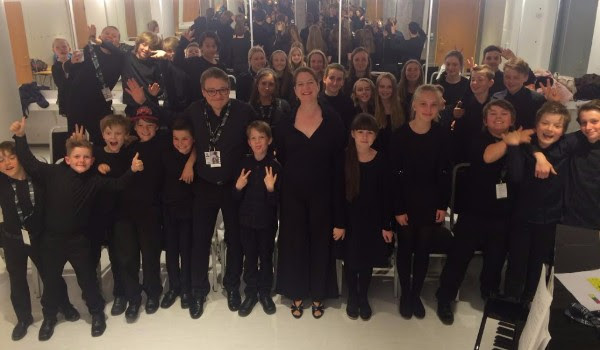Queen of Norway
Hello SFGC Friends from way up north, in Bergen Norway…

…where daylight lingers until after these days, then retires briefly only to emerge again just a few hours later. Some people stereotype Norwegians and other Scandinavians as somewhat humorless, and attribute their severe manner to the severe sun and moon cycles up here—with winter nights just as long as the summer days are now. But I have enjoyed discovering that the Norwegians’ sense of humor is very much intact. Check out this sign outside the Mexican restaurant around the corner from our hotel!

The Philip Glass Ensemble is here in Bergen to present three concerts, one of which was the opening event of the annual Bergen International Arts Festival, a live performance/screening of Philip’s score to Godfrey Reggio’s gorgeous filmPowaqqatsi with the Bergen Philharmonic Orchestra and the Bergen Girls and Boys Choirs. Here I am with the kids, on a break at rehearsal on Wednesday:

That’s their choirmaster Håkon Matti Skrede, who explained to me that the two choruses are part of a big pyramid structure organization, the Edvard Grieg Choirs, that has a large adult amateur choir, a smaller professional chorus, a youth chorus of mixed voices, and these two choruses of boys and girls, respectively. The organization is a centralized, streamlined macro-chorus that provides roles for the opera, choruses of any age or specification for the symphony and special events. It’s very organized!
Also very organized is what happens when The Queen of Norway comes to the opening concert, as she does every year. We had very specific instructions on Wednesday evening, the fulfillment of which made for a unique and somewhat strange concert experience: at 6:45pm all performers except the conductor had to be in place, and the audience was seated as well—no latecomers allowed in the building. Then we all waited in awkward silence until we got the sign that the Queen herself was about to walk in, at which point we all stood as she entered and stayed standing until Her Highness was seated in her favorite seat in row six. At the end of the concert, after the curtain calls, the orchestra also all remained standing in place on stage, audience standing too, so that the Queen could make her exit.
As it turns out, Queen Sonja started life as a commoner, and dated the King in secret for nine years before she married him and thus became royal. Like most hip royals, they have a fab website. An accomplished photographer herself, she is a huge advocate for the arts—and she is passionate about music. In fact, she sponsors an annual international music competition just for singers! It felt especially gratifying to know that I was singing for a dignitary who believes so strongly in the importance of vocal music.
And then I thought, if my experience was slightly different because of her presence, what about the audience? How do you imagine that the presence of Queen Sonja changed the audience’s experience of our performance? And for that matter— what exactly was contained within that performance? Was her entrance a performance too? Were all of the audience members performing? When did the ‘show’ begin, and when did it end? Usually the most celebrated people in a musical performance are the ones on stage, and the audience trains their attention on the performers because of the remarkable things they are doing—singing beautifully perhaps, or interpreting great music with deep humanity. Queen Sonja seems to be a woman of deep humanity too—and certainly great celebrity. But the way she ‘performs’ is very different from the way we make music on stage. What if you were a queen—how would you ‘wear’ your celebrity in your own community?
The feeling of ritual seemed important to this proud local audience, and I noticed a similar love of ritual and pomp last week in Elsinore, Denmark—our last stop. Imagine my surprise when the Elsinore Girls Marching Band marched right up to the café where I was having my morning coffee!
[embed]https://vimeo.com/168371425[/embed]
A strong tradition of military bands in Denmark, combined with a healthy amount of Girl Power, has resulted in a powerful organization with infectious energy. They even made it to Hollywood!
What do rituals do for us? What about pomp (defined as “stately or splendid display”)? Why do people seek these kinds of experiences in their communities? Why do they so often include music? Is a stately ritual a kind of artistic experience? Or is it something else? What rituals do you have?
One of my favorite rituals, of course, is writing ‘home’ to you all. I look forward to seeing many of you in NYC in just a couple of weeks!
Yours truly,
LB
